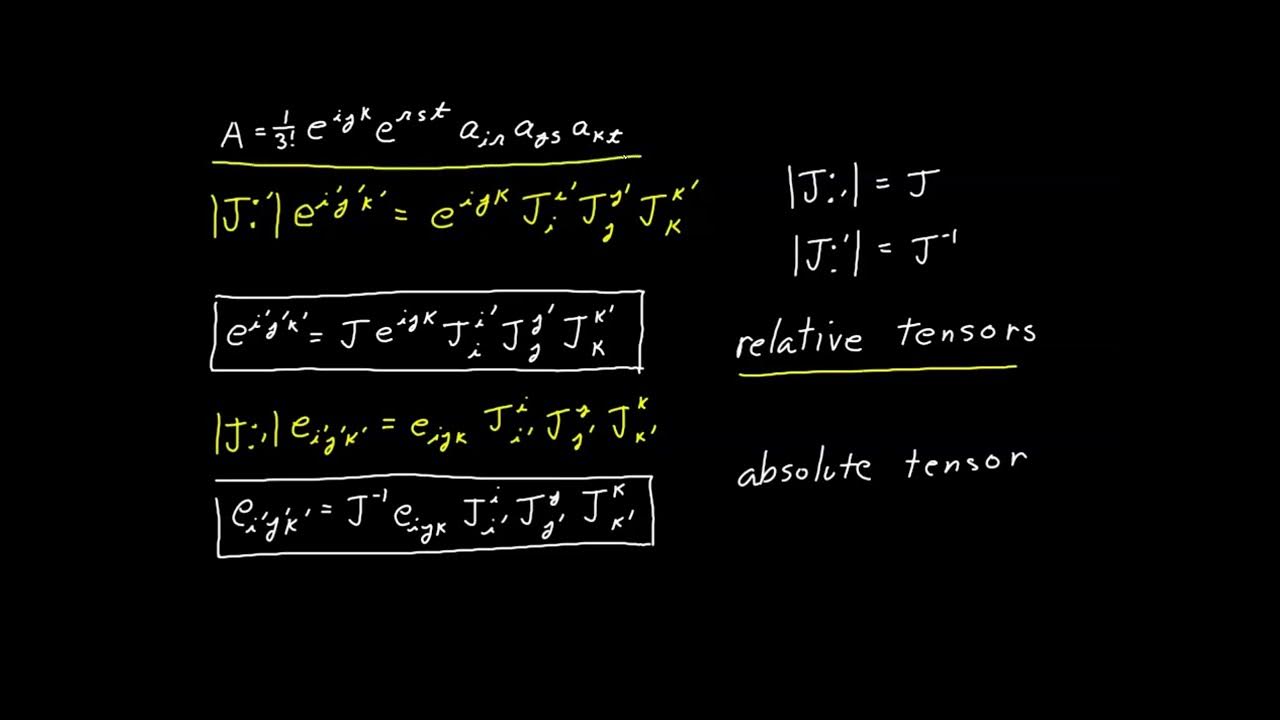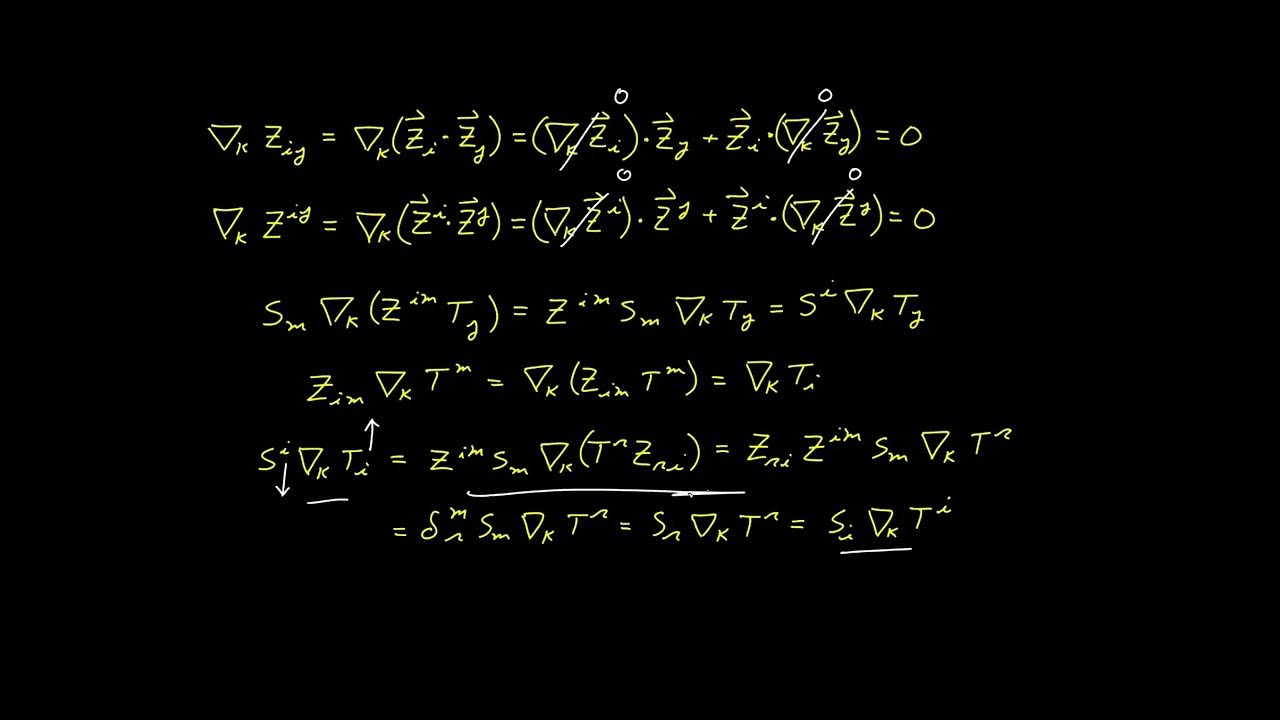Video 20 - Tensor Algebra
TLDRThis video delves into tensor algebra, explaining the equality, addition, and scalar multiplication of tensors. It demonstrates that tensor operations are linear and shows how tensors can be decomposed into vector products. The script illustrates these concepts with examples, proving that the result of these operations is always a tensor, given the appropriate index structures. The importance of unique indexes in tensor products and the ability to decompose higher-rank tensors into sums of vector products is highlighted, setting the stage for further exploration of tensor properties.
Takeaways
- 🔍 Tensor equality is defined by the one-to-one correspondence of equal components between two tensors with the same index structure.
- ➕ Tensor addition involves performing simultaneous addition operations on corresponding components of two tensors with identical index structures.
- 🔢 The result of adding two tensors is always a tensor, provided the tensors have the same rank and index structure.
- 🚫 The converse of tensor addition is not true; a tensor sum does not necessarily imply that the individual summands are tensors.
- 📉 Scalar multiplication of a tensor involves multiplying each component of the tensor by a scalar value, and the result is always a tensor.
- 📚 Tensor operations are linear, meaning that the sum or difference of tensors, as well as scalar multiplication, results in a tensor.
- 🌐 An outer or tensor product is formed by multiplying each component of one tensor by each component of another, resulting in a higher rank tensor.
- 🔑 Unique index selection is crucial for an outer product; no index should be duplicated in either the upper or lower position.
- 📈 The rank of the resulting tensor from an outer product is the sum of the ranks of the two tensors being multiplied.
- 🧩 Any tensor of rank R can be decomposed into a sum of vector products, with the number of terms being n^(R-1), where n is the space dimension.
- 🔑 The decomposition of tensors is a powerful tool for proving properties of higher rank tensors, although it is rarely used in practice.
Q & A
What does it mean for two tensors to be equal?
-Two tensors are equal if and only if each of their individual components is equal to the corresponding component in the other tensor on a one-to-one basis. This requires both tensors to have the same index structure, though the order of the indices does not have to be the same.
How is a tensor addition defined in the context of the script?
-Tensor addition is defined as performing simultaneous addition operations on each corresponding pair of components from two tensors to get a third tensor. For this to be valid, the tensors must have the same index structure.
Why is it necessary for the index structures of tensors involved in addition to be the same?
-The index structures must be the same because each component of one tensor is being added to its corresponding component in the other tensor. If the index structures were different, there would be no clear correspondence between the components to perform the addition.
What does it imply if the result of adding two tensors is also a tensor?
-If the result of adding two tensors is a tensor, it confirms that the operation of addition is closed under the tensor structure. However, it does not necessarily imply that the original tensors were tensors themselves; non-tensor terms can sometimes sum to form a tensor.
How is scalar multiplication of a tensor defined?
-Scalar multiplication of a tensor involves multiplying each component of the tensor by a scalar value. The result is a new tensor where each component is the product of the original component and the scalar.
Why does scalar multiplication always result in a tensor?
-Scalar multiplication results in a tensor because the operation is linear and does not change the index structure of the original tensor. It simply scales each component by a constant factor, preserving the tensor's properties.
What is an outer product or tensor product of two tensors?
-An outer product or tensor product of two tensors is an operation where each component of one tensor is multiplied by each component of another tensor, resulting in a new tensor with a rank equal to the sum of the ranks of the original tensors. The resulting tensor has a unique set of indices, with no duplicates in either the upper or lower position.
What is the significance of the uniqueness of indices in an outer product?
-The uniqueness of indices in an outer product ensures that the operation is well-defined and that the resulting tensor has a clear and distinct index structure. It prevents ambiguity and allows for the proper calculation of the new tensor's components.
How can a higher-rank tensor be decomposed into the sum of vector products?
-A higher-rank tensor can be decomposed into the sum of vector products by expressing it as a sum of outer products of vectors and lower-rank tensors. The number of terms needed for the decomposition is given by n^(r-1), where n is the dimension of the space and r is the rank of the tensor.
What is the practical importance of being able to decompose higher-rank tensors into vector products?
-The ability to decompose higher-rank tensors into vector products provides a theoretical tool for proving certain properties of tensors and understanding their behavior. Although it's rarely necessary to perform such decompositions in practice, knowing that it's possible offers a deeper insight into tensor algebra.
Outlines
📚 Tensor Equality and Algebraic Operations
This paragraph introduces the concept of tensor equality and sets the stage for tensor algebraic operations. It explains that two tensors are considered equal if all their corresponding components match, regardless of the order of indices, provided they have the same index structure. The paragraph also foreshadows the complexity of algebraic operations on tensors and suggests using specific examples for better understanding.
🔢 Tensor Addition and the Nature of Tensors
The second paragraph delves into the specifics of tensor addition, illustrating how two tensors of the same rank with matching index structures can be added together. It emphasizes that the result of such an addition is also a tensor, provided the index structures are consistent. The paragraph also touches on the possibility of tensors being formed by the sum of terms that are not tensors themselves, hinting at the complex nature of tensor operations.
🆚 Scalar Multiplication and Tensor Linearity
This section discusses scalar multiplication, where each component of a tensor is multiplied by a scalar value, and asserts that the result is always a tensor. It further explains that tensor operations are linear, meaning the combination of tensors through addition, subtraction, and scalar multiplication will yield a tensor, given that the initial tensors share the same rank and index structure.
🌐 Tensor Product and Unique Index Rules
The fourth paragraph introduces the concept of the tensor product, or outer product, detailing how two tensors can be multiplied to form a new tensor of higher rank. It outlines the rule that no duplicate indices are allowed in either the upper or lower positions and that the resulting tensor's rank is the sum of the ranks of the original tensors. The explanation includes a step-by-step guide on how to prove that the result of a tensor product is indeed a tensor.
📈 Decomposition of Higher Rank Tensors
The final paragraph explores the decomposition of higher rank tensors into sums of vector products. It explains that any tensor of a given rank can be broken down into a sum of products, each consisting of vectors, according to a specific theorem. The paragraph provides examples of decomposing second and third rank tensors and generalizes the process for tensors of any rank, emphasizing the importance of this theorem for understanding and proving properties of higher rank tensors.
Mindmap
Keywords
💡Tensor
💡Equality of Tensors
💡Addition of Tensors
💡Scalar Multiplication
💡Outer Product
💡Rank of a Tensor
💡Jacobian Factors
💡Linearity of Tensor Operations
💡Decomposition of Tensors
💡Vector Products
💡Tensor Calculus
Highlights
Exploration of algebraic operations involving tensors, emphasizing the complexity of component representation.
Introduction of tensor equality, requiring a one-to-one match of 729 individual components for two sixth-rank tensors in three dimensions.
Clarification that index order does not need to be the same for tensor equality, as long as there is a one-to-one correspondence.
Explanation of tensor addition, involving 81 simultaneous addition operations for fourth-rank tensors in three dimensions.
Proof that the result of adding two tensors is also a tensor, using a transformation with Jacobian factors.
Discussion on the possibility of forming a tensor by adding non-tensor terms, highlighting a unique aspect of tensor operations.
Introduction to scalar multiplication of tensors, where each component of a tensor is multiplied by a scalar value.
Proof that scalar multiplication of a tensor by a scalar always results in a tensor.
Introduction of tensor operations as linear, combining addition, subtraction, and scalar multiplication.
Description of outer product or tensor product, multiplying components of two tensors to form a higher rank tensor.
Emphasis on the uniqueness of indexes in an outer product, avoiding duplicates in upper or lower positions.
Proof that the result of an outer product between two tensors is a tensor of a higher rank.
Theorem stating that any second-rank tensor can be decomposed into the sum of vector products.
Illustration of decomposing a second-rank tensor using arbitrary non-parallel vectors.
Extension of decomposition analysis to third-rank tensors, involving tensor products of vectors and second-rank tensors.
General rule for decomposing tensors of any rank into a set of vector products, with the number of terms being n to the power of (r-1).
Importance of the decomposition theorem for proving properties of higher-rank tensors and its practical applications.
Transcripts
5.0 / 5 (0 votes)
Thanks for rating:





